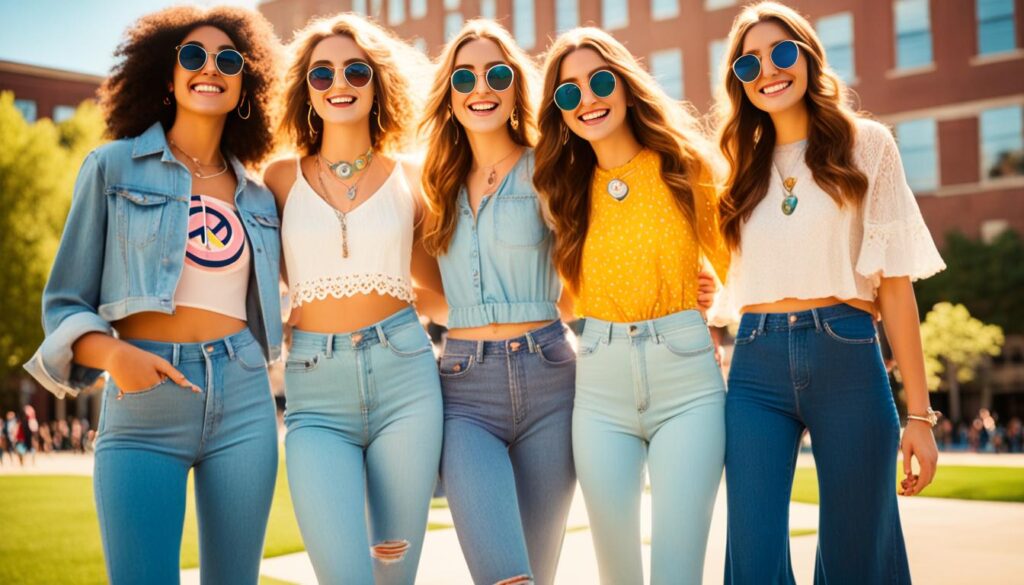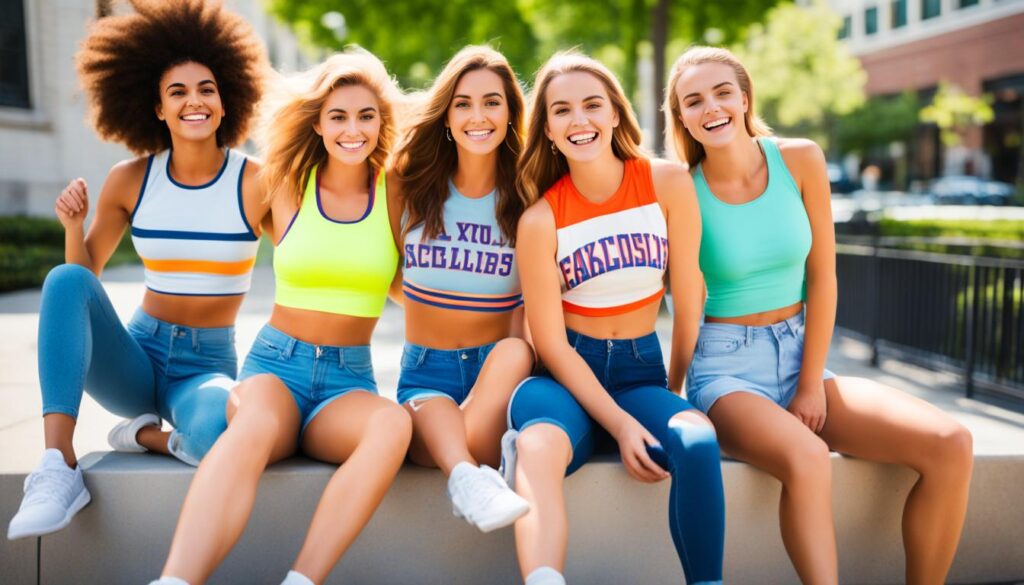Did you know that the 1970s witnessed a daring fashion trend that swept through high schools, challenging societal norms and redefining fashion statements?
The high school braless days of the 70s left an indelible mark on the fashion industry, with students embracing a bold and liberating style that pushed boundaries. It was an era of fearless self-expression and individuality, where fashion choices became a form of activism and rebellion against societal conventions.
Join us as we delve into the world of vintage high school fashion and explore the braless fashion statements that defined this iconic era.
Key Takeaways:
- The 1970s saw high school students embracing bold and liberating fashion choices.
- The braless trend challenged societal norms and exemplified individuality.
- High school fashion of the 70s continues to inspire and influence retro fashion trends today.
- The era represented a pivotal moment of self-expression and activism through fashion.
- Join us on a journey through the vintage styles and braless fashion statements of the 70s.
The Wonder Woman Effect: Lynda Carter as our favorite version of Wonder Woman
When it comes to high school fashion icons, one name stands out from the 70s era: Lynda Carter as Wonder Woman. Her portrayal of this iconic superhero in the 70s television series captivated audiences and solidified her status as a true style icon.
Lynda Carter’s transformation from an ordinary woman to a super-powered hero inspired viewers and had a significant influence on the fashion trends of the era. The empowering and bold design of Wonder Woman’s costume, with its vibrant colors and distinctive elements, continues to inspire and shape fashion trends even to this day.
The impact of Lynda Carter’s portrayal of Wonder Woman on the world of fashion and popular culture cannot be overstated. Her character represented strength, confidence, and female empowerment, which resonated with many women and girls at the time. Wonder Woman became a symbol of strength and liberation, and her fashion choices reflected that.
The Wonder Woman effect was not restricted to the 70s alone. It has transcended time and continues to inspire designers and fashion enthusiasts alike. Wonder Woman’s influence can be seen in various elements of fashion, including powerful female-led designs, bold color palettes, and superhero-inspired clothing.
Lynda Carter’s portrayal of Wonder Woman left an indelible mark on the fashion industry. Her iconic style and character continue to inspire women to embrace their inner strength and showcase their unique sense of fashion. The legacy of Lynda Carter as Wonder Woman serves as a reminder that fashion has the power to empower and transform, leaving an impact that lasts for decades to come.
Lynda Carter as a fashion icon
“Lynda Carter’s portrayal of Wonder Woman in the 70s television series captivated audiences and solidified her as a style icon.”
Wonder Woman’s fashion influence on the 70s
- Empowering and bold design
- Vibrant colors
- Inspired superhero-inspired fashion trends
Continued impact in the fashion industry
“The empowering and bold design of Wonder Woman’s costume, with its vibrant colors and distinctive elements, continues to inspire and shape fashion trends even to this day.”
The Individualistic Fashion Trends of the 1970s
The 1970s was a decade that celebrated individuality and self-expression through fashion. During this vibrant era, fashion enthusiasts embraced a variety of trends that allowed them to truly express their unique styles. Let’s delve into the key fashion trends of the 70s that defined individuality and set the stage for the fashion of today.
Platform Shoes: Adding Height and Glamour
One of the iconic fashion trends of the 70s was the rise of platform shoes. This footwear trend not only added height but also brought a touch of glamour to any outfit. Women and men alike embraced these elevated soles, transforming their look and making a bold style statement. Whether paired with bell-bottoms or miniskirts, platform shoes were a must-have accessory for fashion-forward individuals.
Glitter Fashion: A Shimmering Statement
Another fashion trend that dominated the 70s was glitter-infused clothing. Glitter held a special place in the hearts of fashion enthusiasts, as it became a symbol of self-expression and added a touch of sparkle to any ensemble. Whether it was a glittery top, a shimmering skirt, or even disco-inspired jumpsuits, this trend allowed individuals to showcase their vibrant and carefree spirit.
The Boho Style: Embracing Earthy Aesthetics
The boho style emerged as a prominent trend during the 1970s, embodying a free-spirited and eclectic aesthetic. Characterized by flowing silhouettes, earthy colors, and an emphasis on natural materials, the boho style showcased a sense of freedom and individuality. From peasant blouses to maxi dresses, this fashion trend remains influential in today’s fashion world, highlighting the everlasting appeal of bohemian-inspired looks.
As we look back at the individualistic fashion trends of the 1970s, it’s clear that this era was defined by its celebration of uniqueness and self-expression. The fashion choices of the 70s continue to inspire and influence the fashion industry, reminding us of the power of fashion to express our true selves.

Women’s Fashion in the Early 1970s: Hippie Look and Glamour
In the early 1970s, women’s fashion took inspiration from both the hippie look and glamorous styles, resulting in a unique blend of casual and elegant fashion choices. The continuation of the hippie fashion from the previous decade saw women embracing tie-dye shirts, bell-bottoms, and floral patterns, which reflected their free-spirited nature and connection to nature.
But it wasn’t just about embracing the carefree hippie lifestyle. The era of the mini skirt symbolized a significant shift in women’s liberation and confidence. Mini skirts became a fashion statement that allowed women to break free from traditional norms and express their femininity in bold and empowering ways. With their daring length, mini skirts showcased the wearer’s legs and became synonymous with the social changes occurring at the time.
Aside from mini skirts and bohemian patterns, the early 1970s also introduced glamorous elements into women’s fashion. Accessories played a crucial role in elevating everyday outfits to a new level of elegance. Cloche hats, with their unique bell-shaped design, added a touch of sophistication and captured the essence of the Art Deco era. Chunky high heels not only provided comfort but also enhanced the overall glamour of any ensemble, giving women confidence and poise.
The Glamorous Yet Casual
The fashion of the early 1970s allowed women to strike a balance between casual comfort and glamorous allure. The combination of the hippie look with elegant accessories created a unique style that surpassed the boundaries of traditional fashion norms.
“The fashion choices of the early 1970s allowed women to embrace their individuality and express their femininity through a diverse range of clothing and accessories.”
The Key Elements
To fully capture the essence of women’s fashion in the early 1970s, several key elements came together to create the iconic look:
- The Hippie Look: Tie-dye shirts, bell-bottoms, and floral patterns
- The Mini Skirt Revolution: Embodying women’s liberation and confidence
- Glamorous Accessories: Cloche hats and chunky high heels
A Glimpse into the Past
Step back in time and revisit the early 1970s, where women’s fashion embraced both the carefree spirit of the hippie culture and the allure of glamorous accessories. It was a time when women could express their femininity and assert their confidence through their clothing choices. The early 1970s style remains a beloved and influential era in fashion history, leaving a lasting impact on future generations.
| Glamorous | Casual |
|---|---|
| Cloche hats | Tie-dye shirts |
| Chunky high heels | Bell-bottoms |
| Mini skirts | Floral patterns |
Women’s Fashion in the Mid-1970s: Casual Looks and Activewear
The mid-1970s marked a significant shift in women’s fashion, as comfort and versatility took precedence. Women embraced casual styles that emphasized ease and relaxation in their everyday attire. Sweaters, jeans, and khakis became staples, providing a laid-back yet fashionable look. Additionally, the rise of activewear, such as jumpsuits and leisure suits, catered to the growing demand for comfortable and practical clothing.
During this era, vintage clothing gained popularity, adding a touch of nostalgia to women’s outfits. Embracing retro fashion trends became a way for women to showcase their unique sense of style while paying homage to the past. From mod-inspired mini dresses to flowy boho-chic ensembles, vintage pieces became a statement of individuality and self-expression.

Conclusion
The high school braless days of 70s fashion marked a pivotal moment in the history of fashion, pushing boundaries and promoting body acceptance. The bold and daring fashion choices of that era continue to serve as a powerful source of inspiration and empowerment for women today.
As we reflect on the impact of fashion on body image, it is crucial to advocate for ending body shaming and fostering gender equality in the industry. By embracing individuality and celebrating the diversity of women’s bodies, we can foster a more inclusive and accepting fashion culture.
Let us continue to challenge societal norms and promote body acceptance, recognizing that fashion has the power to shape perceptions and influence self-esteem. Together, we can create a future where every woman feels confident and proud of her unique beauty. It is time to embrace a fashion industry that values all body types and promotes gender equality.